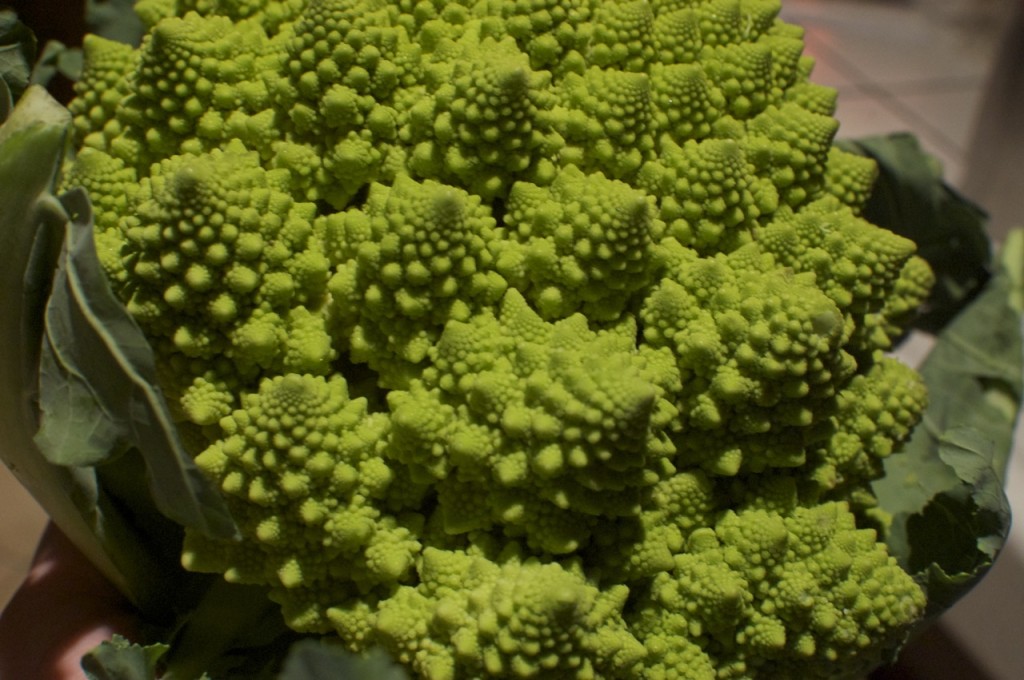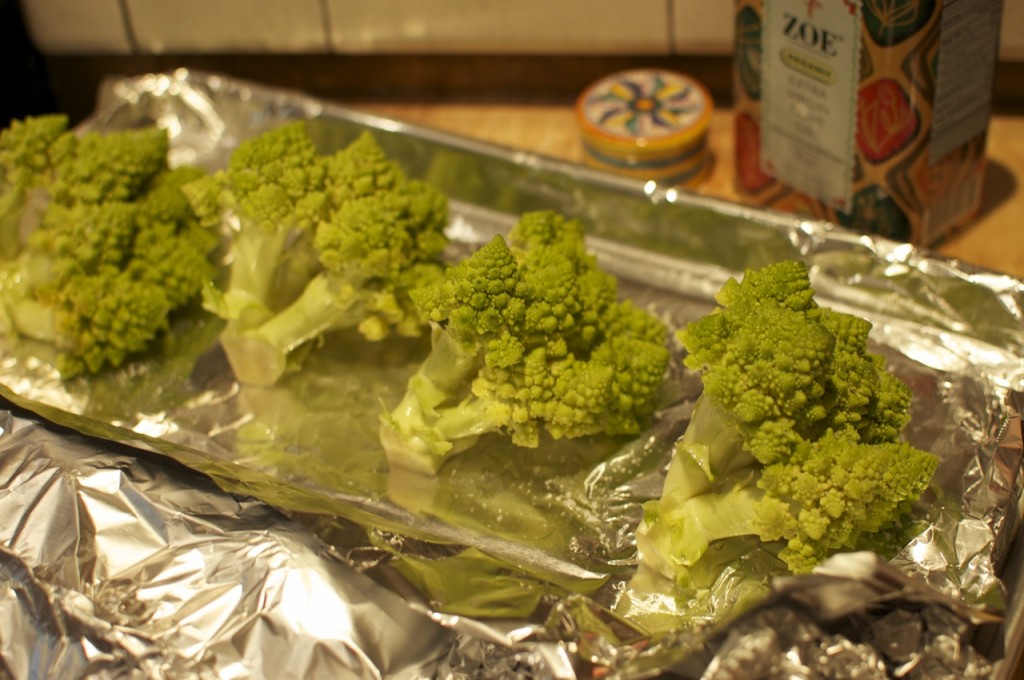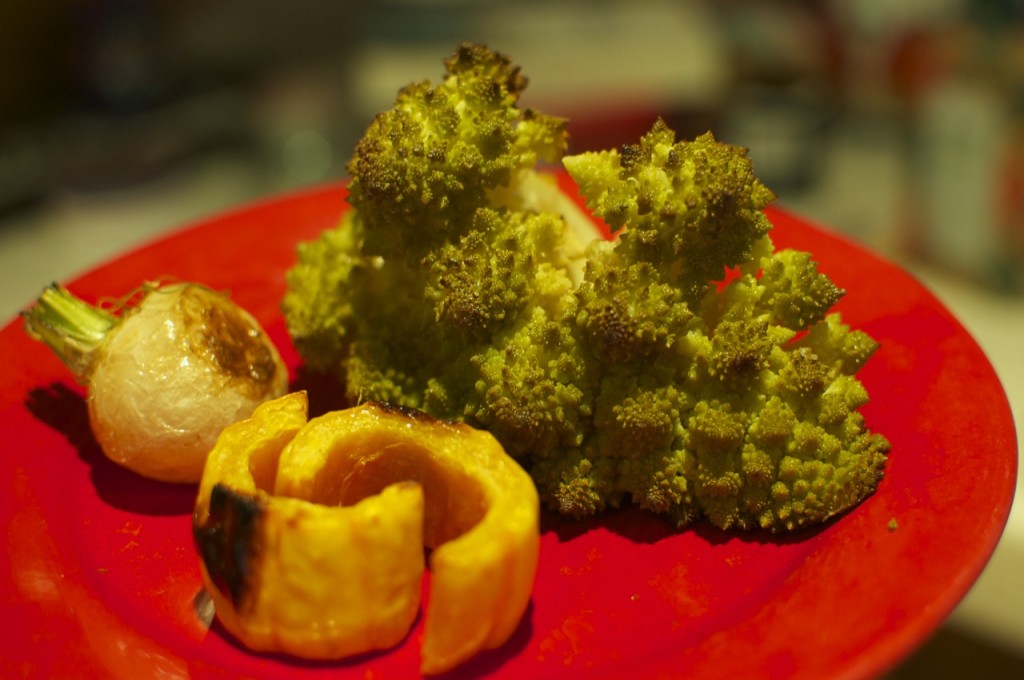Right now there’s a deluge going on here in Southern California, something we should be happy about, seeing as we’re in the midst of a beastly drought that threatens to destroy crops and livelihoods. But rain like this is troubling because the ground can’t absorb it all at once, causing the roads to morph into fast moving rivers and the mountainsides to lose their grip and slide down onto whatever is below them, be it a neighborhood, a school or a business district.
While I love rain, this kind distracts me. So rather that focusing on the writing I need to do, I’ve been in the kitchen today, roasting every vegetable that will allow it. Lettuce doesn’t need it, so it’s safe for now. Even the radishes will eventually get their turn in the heat, thanks to my friend Molly’s brilliant idea for glazing them. (Okay, so she got the recipe from the cookbook of another amazing Molly.)
But then there’s this head of romanesco cauliflower, with all those florets that look like the tops of a lot of the Buddhist temples I’ve seen in southeast Asia. (I’ve decided I don’t like the word “floret.” It sounds like something you put in your shoes to make them smell better. Ick.)
Confession time: The first time I got a romanesco in my CSA box I let it go bad.
This sounds stupid, but I was intimidated by its beauty and exoticism. So I let it sit until it was unfit for consumption. By the time I threw it out, it was clearly inedible but still pretty in a creepy Miss Havisham way, if Miss Havisham had been a cauliflower.
I resolved not to let that happen again. But another romanesco arrived a few days ago, and once again I have let it sit. I glance at it every time I open the fridge door, giving it a sidelong peek as I reach past it for the yogurt, as if it were the handsome guy in class who couldn’t possibly ever be interested in me, so why should I bother trying to make eye contact and speak?
So today as I prepped turnips, squash, garlic, beets, both red and golden, and potatoes, both sweet and not, slathering everything in olive oil and blessing it with flaked sea salt, I spied that lovely romanesco sitting on the top shelf of the fridge like a perfect wedding cake left in the detritus of a picnic. I pulled it out and cradled it in my hands for a couple of minutes. How could I take a knife to those lovely regiments of whatever we must agree to call them instead of florets?
That’s when it hit me–I’d have to make my assault on the back side of this thing. So I took a knife and cut down the stem to halve and then quarter it long ways. Each quarter made a perfect serving size, and the peaks remained intact.
I dappled the quarters with olive oil, sprinkled them with sea salt and put them into the 450°F oven with all those other vegetables, which I poked and prodded every so often to determine when something was ready to come out. When they started to char just a bit (after about 15 minutes), I tented them with some aluminum foil to keep them from burning. When I could easily slip the knife tip into the thickest part of the stem (about another 15 minutes later), I knew they were done.
Romanesco really doesn’t need anything else, although a light vinaigrette would be good on it. So would a dab of hollandaise. But while I’m here alone (Himself is off in the wilds of Washington’s Olympic Peninsula on a writing retreat), I may eat it all with just that touch of sea salt. With my fingers. Standing at the counter. And listening to the rain.




















I love your writing. I have to follow it to the end, even though my Southern self is asking what you did with the greens. I have heard tells of people who eat turnips. I even know some brave souls who dice some up in their greens, but to eat the waste of the turnip out right…
Thanks, Suzanne!
Alas, the CSA box provided the turnips and beets without their greenery attached. When I buy them at the grocery or farmers’ market, I definitely use the leaves, too. Turnip greens can be a little horsey, so I mix them with other greens, like beet greens, to help temper them. Beet greens are sweeter and more delicate. Chard is another good one to combine. I use the stems, too, and give them a head start on the cooking, sauteing the greens mixture with sliced garlic, a sprinkling of red pepper flakes and a wee splash of apple cider vinegar or red wine vinegar. Salt & pepper as needed.
As for turnips themselves, I’ve always had a troubled relationship with them. I did come to respect them in culinary school, where I learned not to boil the living daylights out of them. For more on my turnip evolution, check out my essay in Leite’s Culinaria, “I Hated Caroline Kennedy” http://leitesculinaria.com/77308/writings-i-hated-caroline-kennedy.html.
Cheers!
Carol
Hi Suzanne,
Tamar Adler in her lovely and wise book An Everlasting Meal, says “leaves and stalks are parts of a vegetable, not obstacles to it.”
I occasionally go back and reread this book–it may be the best one I’ve found yet on cooking. Give it a read for more of these nuggets and for some great inspiration on what to do after you’ve gone nuts at the farmers’ market…
http://www.amazon.com/Everlasting-Meal-Cooking-Economy-Grace/dp/1439181888/ref=sr_1_1?s=books&ie=UTF8&qid=1393784027&sr=1-1&keywords=an+everlasting+meal
Bon appetit!
Carol